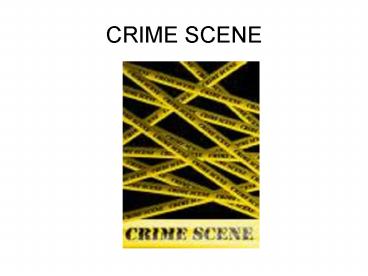CRIME SCENE - PowerPoint PPT Presentation
1 / 27
Title:
CRIME SCENE
Description:
Notification info- date, time, method of notification, info received ... Best used on crime scenes with no barriers like the open water or open road ... – PowerPoint PPT presentation
Number of Views:469
Avg rating:3.0/5.0
Title: CRIME SCENE
1
CRIME SCENE
2
Defining a Crime Scene
- The only thing consistent about crime scenes is
their inconsistency
3
Primary Crime Scene
- The site of the original crime scene
- the scene of the first criminal activity
- Any scene that is subsequent to the primary scene
is known as secondary. - Classification does not infer any priority or
importance rather gives designation of sequence
of locations.
4
Macroscopic Crime Scene
- Based on size
- Ex victims body
- Ex wounds on body
- Ex the ground near the body
5
Microscopic Crime Scene
- Based on size (smaller thing)
- Ex trace evidence
- Ex gunshot residue
- Ex Tire treads
- Ex hair samples
- Ex mites found in clothes
6
Classification based on type of crime committed
- Homicide
- Robbery
- Sexual assault
- Vehicular homicide
- Battery
- Arson/bomb
- Terrorism/ bioterrorism
7
Other Classifications
- Crime Scene Condition
- Organized or disorganized
- Physical location of the crime scene
- Indoors, outdoors, street, alley, in vehicle,
near vehicle - Criminal behavior associated with the scene
- Passive or aggressive
8
No one description
- Or definition ever works for every crime scene.
- The crime scene is never by boundaries
- The crime scene investigator MUST always be
constantly evaluating and frequently changing the
defined area
9
Basic four processing steps in forensic
examinations
- RECOGNITION
- Survey the scene
- Documentation
- Collection ad preservation
- IDENTIFICATION
- Comparison testing
- INDIVIDUALIZATION
- Evaluation and interpretation
- RECONSTRUCTION
- Reporting and Presentation
10
Types of information obtained from examination of
physical evidence
- Information on the Corpus Delicti
- Information on the Modus Operandi
- Linkage of persons, scenes, and objects
- Proving or disproving witness statements
- Identification of suspects (AFIS/CODIS)
- Identification of unknown substances
- Reconstruction of a Crime
- Providing Investigative Leads
11
Defined
- Corpus Delicti- Body of crime- refers to the
principle that it must be proven that a crime has
occurred before a person can be convicted of
committing the crime - Modus Operandi a method of procedure or
operation that indicates or suggests the works of
a single criminal in more than one crime.
12
PART 2
- CRIME SCENE PRODUCERS
13
First Responders
- Usually the police officers or fire department
(firefighters and paramedics) - They are responsible for NOT destroying evidence
- SAFETY is the primary concern of first responders
14
The Duties of the First Responder
- Assist the victim
- Search for and arrest the suspect if still on
scene - Detain all witnesses
- Protect the crime scene (barrier tape, official
vehicles, security log - A security log MUST be kept of all persons
entering the crime scene and leaving. No
drinking, no smoking, no eating, no unnecessary
personnel, no contamination (typically- no
officer wants this job) - Note and communicate ALL movement within/ around
the crime scene
15
Other crime scene procedures
- Securing the crime scene- Locards Exchange
Principle - Crime Scene Survey- Walk-through done by lead
detective - Crime scene documentation- note-taking,
videography, photography, sketching - All FOUR are necessary and one does not
substitute any other
16
Note-taking at the crime scene
- VERY IMPORTANT- accurate crime scene notes may be
referred to by investigators. DETAILS are a
must!!! - Notification info- date, time, method of
notification, info received - Arrival info- date and time responded, who was
present, personnel present - Scene description- weather, location, major
structures, point(s) of entry, clothing,
furniture, trash cans, weapons - Victim description- do not move body, lividity,
wounds, clothes, jewelry, identification present? - Crime Scene Team (CSI) time the teamnotice
evidence handling
17
Crime Scene Search Methods
- Link Method
- Line Method
- Grid Method
- Zone Method
- Wheel Method
- Spiral Method
18
LINK METHOD
- Most common and productive method
- Says one type of evidence leads to another
- Works with all crime scenes
19
Line Method
- Works best on large, outdoor scenes
- Requires search coordinator (volunteers)
20
Grid Method
- Modified double-line search
- Effective, but time consuming
21
Zone Method
- Best used on scenes with defined zones, like in
homes, buildings, locker rooms - Good for warrant searches
22
Wheel Method
- Used for special situations
- Limited applications, best used on small,
circular crime scenes
23
Spiral Method
- Best used on crime scenes with no barriers like
the open water or open road - Requires the ability to trace a regular pattern
with fixed diameters
24
Crime Scene Sketch
25
Take NOTES on what happened here
26
Sketch what happened here
27
What METHOD would you use to analyze this scene?































